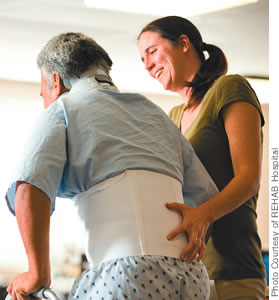Improving Function And Mobility
Interviewed by Melissa Moniz
Wednesday - March 19, 2008
E-mail this story | Print this page | Comments (0) | Archive
 Del.icio.us Share
Del.icio.us Share

Dr. Ton Ming Chiang
Associate Medical Director at Rehabilitation Hospital of the Pacific and Medical Director of the Sub-Acute Rehabilitation Unit
Interviewed by Melissa Moniz
What is your area of specialty?
I am a physiatrist - physiatry is the medical specialty of physical medicine and rehabilitation. Although the scope of practice includes neurological conditions (including stroke, brain injury and spinal cord injury), I primarily treat patients with musculoskeletal injuries and orthopedic conditions.
How long have you been working at REHAB?
About 30 years.
Can you explain what a typical workday is like for you?
A typical day is anywhere from 10 to 16 hours long. I see scheduled and unscheduled patients. Some are new admissions. About 85 percent of the patients I see are inpatients - in the hospital. And about 15 percent are outpatients.
What are the most common orthopedic problems you see?
The most common orthopedic conditions I see at REHAB are major multiple trauma, fractures and joint replacement.
As a physiatrist specializing in orthopedic conditions, do both physiatry and orthopedics always work hand-in-hand when helping a patient?
Yes, the orthopedic surgeon and physiatrist work as a team. The orthopedic surgeon performs the procedure and diagnosis. The physiatrist follows the patient’s condition through rehabilitation to help the patient through the entire therapy process, and that can include prescribing psychological consultation. This is especially true for persons with catastrophic conditions, to help them improve function, to return to community and to have a more productive lifestyle.
What is normally the biggest obstacle for patients with joint replacements?
The biggest obstacle for these patients is impairment of mobility and function that includes weakness of muscle, pain and range of motion.

|
Have there been any recent medical advancements that have really helped your patients?
There are new technological improvements for surgical procedures, prosthetics and braces. There is new technology developing to monitor the progress and function of patients. Like computers, more designs are coming out and a lot of instruments are being developed.
Can you explain the general process when a patient arrives?
After the patient registers at the admissions office, a nurse evaluates the patient. The physiatrist performs an examination to include the person’s history and to access their musculoskeletal condition in addition to any additional medical condition. The treatment plan for the patient is developed and the various aspects of rehabilitation are prescribed. This can include physical therapy, occupational therapy, speech pathology, nutrition, nursing services, as well as psychological consultation. It takes teamwork to integrate a program with short-term and long-term goals.
What has changed the most in your profession since you first started?
There have been a lot of changes! Tremendous changes have occurred, such as information technology, advancements in neuroscience, in therapy procedures, state-of-the-art materials are available for braces and prosthetics, and therapeutic equipment and devices are being developed at a rapid rate. REHAB has a state-of-the-art machine that has replaced the whirlpool for arm and hand recovery. It is Fluidotherapy - a dry, heated, self-sanitizing machine that allows the therapist to introduce therapeutic exercises during a session and can accelerate recovery.
Do patients with joint replacements, complex orthopedic injuries and extremity amputations generally need long-term rehabilitation?
Inpatient rehabilitation for joint replacement may take up to three weeks, with home therapy and outpatient therapy following discharge from the hospital. Complex conditions, major-multiple trauma with head injury, and amputation can take up to a few months or longer with home therapy and outpatient therapy following discharge from the hospital.
In your opinion, what aspect of your job is the most challenging?
Because we treat the entire person, probably the most challenging are the complex, catastrophic conditions because these usually include psychological rehabilitation.
E-mail this story | Print this page | Comments (0) | Archive
Most Recent Comment(s):













